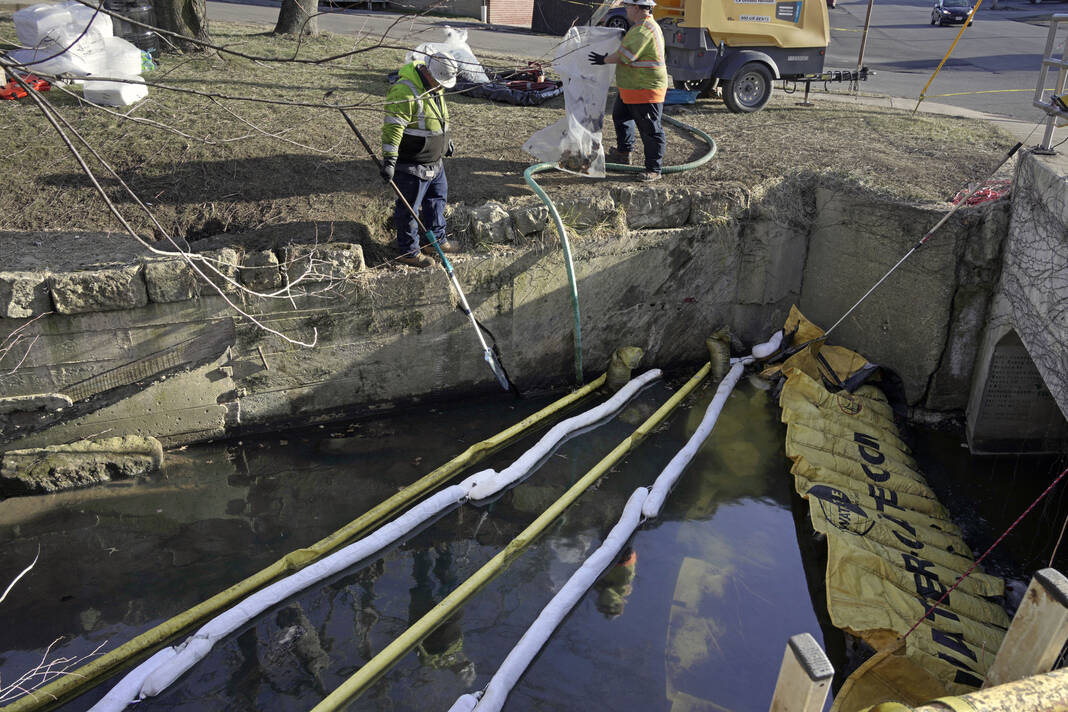
Booms are placed in a stream that flows through the center of East Palestine, Ohio, Wednesday, Feb. 15, 2023, as cleanup continues following the derailment of a Norfolk Southern freight train over a week ago. (AP Photo/Gene J. Puskar)


EAST PALESTINE, Ohio (AP) — The head of the U.S. Environmental Protection Agency got a first-hand look Thursday at a creek contaminated by a freight train derailment in Ohio that spilled toxic chemicals and burned in a huge plume over homes and businesses.
The visit by EPA Administrator Michael Regan, who stood along a waterway still reeking of chemicals nearly two weeks after the derailment, came a day after residents of the Ohio village of East Palestine packed a meeting and demanded to know if they’re safe.
Regan said he was confident that technology being used to clean up the mess would protect public health. But residents are frustrated by what they say is incomplete and vague information about the lasting effects from the disaster.
“I have three grandbabies,” said Kathy Dyke, who came with hundreds of her neighbors to Wednesday’s meeting at a gymnasium, where representatives of railroad operator Norfolk Southern were conspicuously absent. “Are they going to grow up here in five years and have cancer?”
State officials insisted yet again that testing shows the air is safe to breathe around East Palestine, where just under 5,000 people live near the Pennsylvania state line. They promised that air and water monitoring would continue.
Many who had waited in a long line snaking outside the gym came away frustrated that they didn’t hear anything new. Some booed or laughed each time they heard the village mayor or state health director assure them that lingering odors from the the huge plumes of smoke aren’t dangerous and the water is fine to drink.
In the nearly two weeks since the derailment forced evacuations, residents have complained about suffering from headaches and irritated eyes and finding their cars and lawns covered in soot. The hazardous chemicals that spilled from the train killed thousands of fish, and residents have talked about finding dying or sick pets and wildlife.
Those attending Wednesday’s informational session, originally billed as a town hall meeting, had many questions over health hazards, and demanded more transparency from Norfolk Southern.
“They just danced around the questions a lot,” said Danielle Deal, who lives a few miles from the derailment site. “Norfolk needed to be here.”
In a statement, Norfolk Southern said it didn’t attend alongside local, state and federal officials because of a “growing physical threat to our employees and members of the community around this event.”
Deal called that a “copout.” She and her two children left home to stay with her mother, 13 miles (20 kilometers) away “and we could still see the mushroom cloud, plain as day,” she said.
Even with school back in session and trains rolling again, the people remain worried.
“Why are they being hush-hush?” Dyke said of the railroad. “They’re not out here supporting, they’re not out here answering questions. For three days we didn’t even know what was on the train.”
The hundreds of families who evacuated said they want assistance figuring out how to get the financial help the railroad has offered. Beyond that, they want to know whether the railroad will be held responsible.
Ohio Attorney General Dave Yost advised Norfolk Southern on Wednesday that his office is considering legal action.
“The pollution, which continues to contaminate the area around East Palestine, created a nuisance, damage to natural resources and caused environmental harm,” Yost said in a letter to the company.
Norfolk Southern announced Tuesday that it is creating a $1 million fund to help the community of some 4,700 people while continuing remediation work, including removing spilled contaminants from the ground and streams and monitoring air quality. It also will expand how many residents can be reimbursed for their evacuation costs, covering the entire village and surrounding area.
“We will be judged by our actions,” Norfolk Southern President and CEO Alan Shaw said in a statement that also said the company is “cleaning up the site in an environmentally responsible way.”
At least five lawsuits have been filed against the railroad and attorneys from several firms met with dozens of residents this week at an information session to offer advice.
Ohio Gov. Mike DeWine on Thursday asked the White House for on-the-ground help from a federal health and emergency response team and the Centers for Disease Control and Prevention.
No one was injured when about 50 cars derailed in a fiery, mangled mess on the outskirts of East Palestine on Feb. 3. As fears grew about a potential explosion, officials seeking to avoid an uncontrolled blast had the area evacuated and opted to release and burn toxic vinyl chloride from five rail cars, sending flames and black smoke billowing into the sky again.
The state’s Environmental Protection Agency said the latest tests show five wells supplying the village’s drinking water are free from contaminants, but recommended testing private water wells that are closer to the surface.
The Ohio Department of Natural Resources estimates spilled contaminants affected more than 7 miles (11 kilometers) of streams and killed some 3,500 fish, mostly small ones such as minnows and darters. Precautions are being taken to ensure contaminants that reached the Ohio River don’t make it into drinking water, officials said.
There have been anecdotal reports that pets or livestock have been sickened. No related animal deaths have been confirmed, state officials said, but that confirmation would require necropsies and lab work.
The suspected cause of the derailment is a mechanical issue with a rail car axle. The National Transportation Safety Board said it has video appearing to show a wheel bearing overheating just beforehand. The NTSB expects to issue its preliminary report in about two weeks.
Misinformation and exaggerations spread online, and state and federal officials have repeatedly offered assurances that air monitoring hasn’t detected any remaining concerns. Even low levels of contaminants that aren’t considered hazardous can create lingering odors or symptoms such as headaches, Ohio’s health director said Tuesday.

